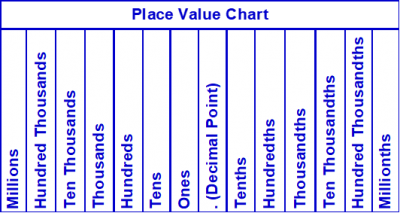As illustrated below and by other available place value solutions, this application will find the place values of the digits in a number with the aid of a place value chart.
Students in the 3rd grade should know how to find the place values of the digits in a number up to 999 under Common Core and Texas Essential Knowledge and Skills standards. Learning the concept of place value begins with a place value chart. A place value chart is composed of columns that correspond to values. Those values increase by a factor of 10 from right to left. Alternatively, those values decrease by a factor of 10 from left to right. For example, the Tens column corresponds to a value of 10 and the Hundreds column corresponds to a value of 100.

Each digit in a number is mapped to a separate column in the chart based on the position it occupies. In order to find the place values of the digits in a number, the product of each digit and the value of its corresponding place must be determined. In other words, the ability to multiply is essential to finding the place values of the digits in a number.
As illustrated by the example of 326.23 below, the application above returns a place value chart. The digits in are placed in the columns corresponding to the position they occupy in the number entered. The chart also includes the resulting product between the digits and the values or multipliers for each place. Those products represent the place values of the digits in the number entered. And finally, the application returns a list of the place values in fraction and decimal form if applicable.

The results returned demonstrate how to find the place values of the digits in a number. They also reflect the importance of understanding the concept of place value as the sum of the place values of the digits equals the number entered (300+20+6+0.2+0.03=326.23). That sum is known as the expanded form of the number.

